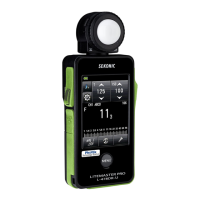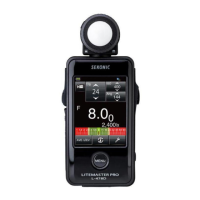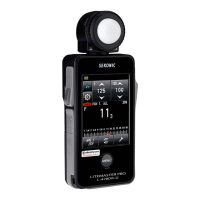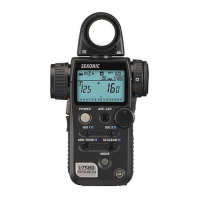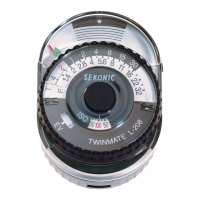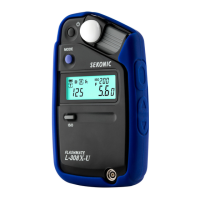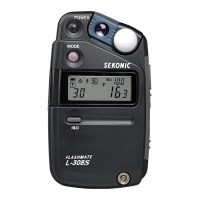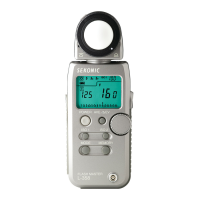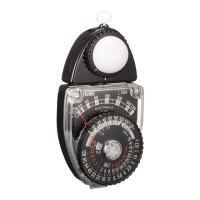Do you have a question about the Sekonic Litemaster Pro L-478D and is the answer not in the manual?
Detailed description of the light meter's physical components and their functions.
Instructions for attaching the safety strap to the light meter.
Step-by-step guide for correctly inserting AAA batteries.
How to turn the light meter on and off using the power button.
How to check the remaining battery power indicator on the LCD screen.
Important safety notes and procedures for battery replacement.
Explanation of the automatic power-off feature to save battery.
How to interact with the meter's touch screen for various operations.
Method to prevent accidental operations by locking the touch screen.
Visual representation of the meter's screen navigation and flow.
Detailed layout and components of the main measuring display screen.
Displays detailed settings, meter information, and status.
Access point for various settings and functions via icons.
Main menu for accessing all meter settings and operations.
A step-by-step guide outlining the general workflow for using the meter.
How to configure the meter for incident or reflected light measurements.
Guide to selecting the appropriate mode for different lighting scenarios.
Procedures for measuring continuous light sources like sunlight or lamps.
Instructions for measuring the output of electronic flash units.
How to use the meter with radio-controlled flashes for triggering and measurement.
How to interpret and handle over or under exposure readings.
How to store and recall up to nine measured values for comparison.
Adjusting the measured value to the center of the analog EV scale.
Calculating the average of multiple memorized measurements.
Evaluating studio lighting and checking background evenness.
Applying compensation for lens or light source filtration.
Accessing and configuring various meter settings via the menu.
Advanced settings like user calibration and factory reset.
Detailed description of the light meter's physical components and their functions.
Instructions for attaching the safety strap to the light meter.
Step-by-step guide for correctly inserting AAA batteries.
How to turn the light meter on and off using the power button.
How to check the remaining battery power indicator on the LCD screen.
Important safety notes and procedures for battery replacement.
Explanation of the automatic power-off feature to save battery.
How to interact with the meter's touch screen for various operations.
Method to prevent accidental operations by locking the touch screen.
Visual representation of the meter's screen navigation and flow.
Detailed layout and components of the main measuring display screen.
Displays detailed settings, meter information, and status.
Access point for various settings and functions via icons.
Main menu for accessing all meter settings and operations.
A step-by-step guide outlining the general workflow for using the meter.
How to configure the meter for incident or reflected light measurements.
Guide to selecting the appropriate mode for different lighting scenarios.
Procedures for measuring continuous light sources like sunlight or lamps.
Instructions for measuring the output of electronic flash units.
How to use the meter with radio-controlled flashes for triggering and measurement.
How to interpret and handle over or under exposure readings.
How to store and recall up to nine measured values for comparison.
Adjusting the measured value to the center of the analog EV scale.
Calculating the average of multiple memorized measurements.
Evaluating studio lighting and checking background evenness.
Applying compensation for lens or light source filtration.
Accessing and configuring various meter settings via the menu.
Advanced settings like user calibration and factory reset.
| Light Receptor Element | Silicon Photodiode |
|---|---|
| Aperture Range | f/0.5 to f/161.2 |
| Power Source | 2 x AAA batteries |
| Memory | Yes |
| Type | Digital light meter |
| Measuring Modes | Ambient, Flash |
| Cine Speed | 1 to 250 fps |
| Wireless Triggering | Yes (via PocketWizard) |
| Connectivity | USB |
| EV Range | -2 to 22.9 (at ISO 100) |
| Weight | 120g (without batteries) |
